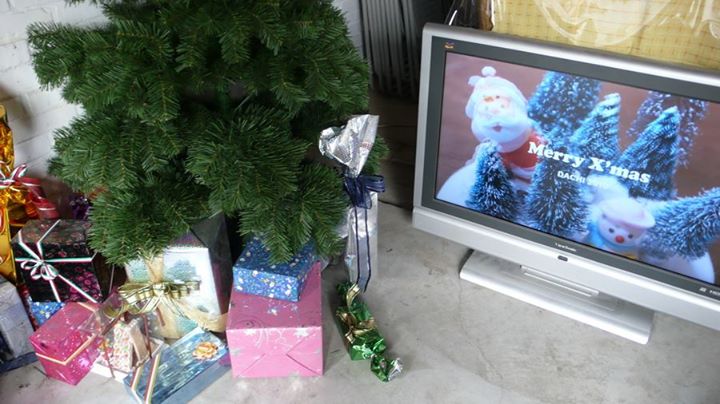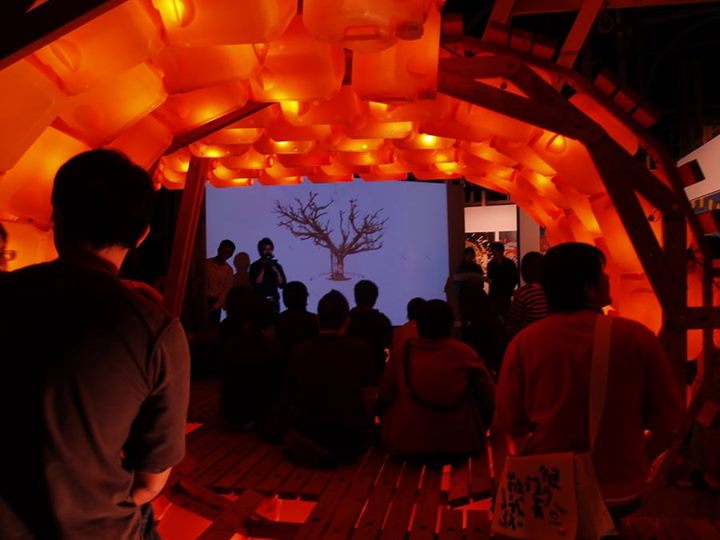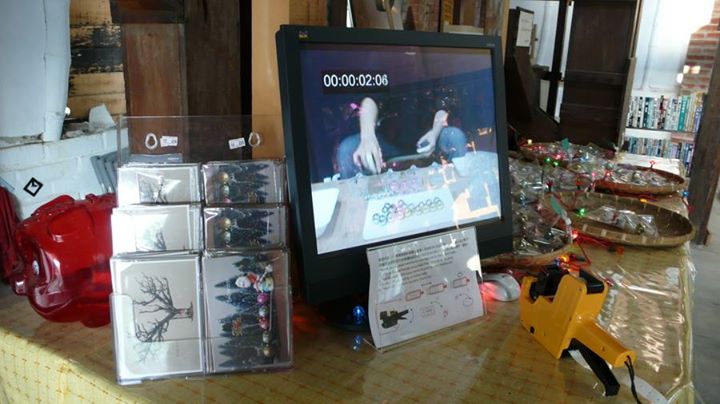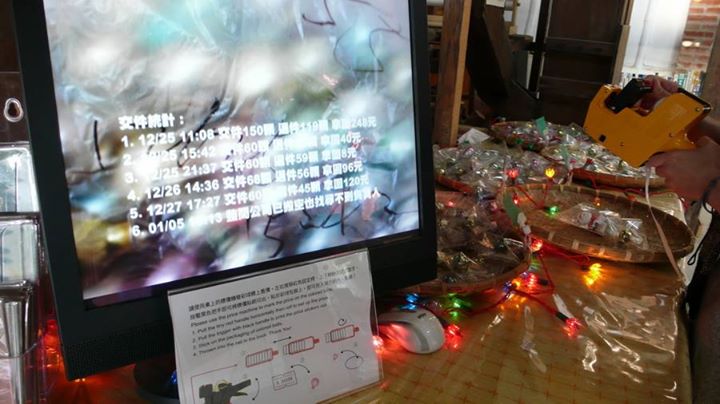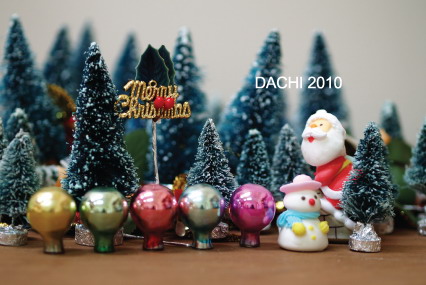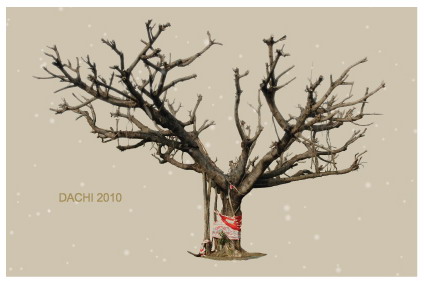民國六十四年,謝東閔喊出「家庭即工廠」的口號,鼓吹家庭代工,打造出台灣經濟奇蹟。而「藝術創作」究竟是生產活動抑或消費行為?作者從事「家庭代工」作為行動,意圖找尋某種藝術圈外的「勞動價值」來對照藝術圈內勞動者(創作者)「自願受騙」的天真。
自2002 年起,作者提出「家庭主婦藝術創作計畫」將「家庭/ 居住空間」的私領域作為創作發表的空間,喊出「客廳即展場」的口號。除了對於作品主流展演空間的思考外,關於是否「勞動即生產?」以及藝術體制背後的產業關係,其生產與消費的邏輯為何?也是當時的提問之一。於是,在報紙分類廣告中尋找家庭代工的機會,企圖以家庭代工的勞動來取代藝術創作的勞動,並暗諷其間的勞力剝削甚至是詐騙關係的雷同。
作者尋找到製作「玻璃彩球」的家庭手工,在預付12000 元的材料成本費用,以完成一顆成品8塊錢的報酬下簽約,殊不知一切看似合理的約定背後,是找不到上訴管道的不合理退件的詐騙手法。在實踐過程中,某種創作者的偏執引領作者跟詐騙集團拼到底的加倍認真製作,做出自認無可挑剔的成品,卻仍被毫無理由依據的退貨。幾經往返,最終詐騙集團整間公司搬空消失,而這些彩球也失去了交付的對象。若仔細觀察這些作者產出的「玻璃彩球」,會發現其處在一種彷彿尚未完成裝配的半成品狀態,無論其裝飾性或實用功能性皆曖昧懸置,脫離了日常的現實性,更像是詐騙集團為了騙錢而虛構出生產的空需求與假目的。
根據馬克思主義理論,剩餘價值是指剝削自勞動者勞動價值中的利潤,亦即勞動價值和工資之間的差異,是「被資產階級無償佔有的勞動」。但藝術的剩餘價值是否也建立在勞動價值的剝削中呢?
在《近身潛獵-向歷史投影》展覽期間(2010/12/5-12/26),正好是所謂「聖誕節」的主要慶祝期,城市中四處可見相關的節慶符號與消費活動充斥街頭。作者藉由在展場佈置一個「慶祝聖誕節」的情境,使作者從事家庭代工所產出的「玻璃彩球」重新獲得作為商品的機會,在八年後,作者努力行銷包裝這些彩球後,究竟它們的價值會是多少?就交由觀眾為它們貼上的標價來決定。
將「聖誕節」帶進大崎村,對於當地農民的生活與信仰來說,是多麼不合時宜又莫名其妙的事(或許藝術也是)。但作者進行了大崎村老榕樹與聖誕彩球的影像創作,企圖藉由將老榕樹帶進南藝也同時邀請大崎居民踏進南藝,讓大崎也有介入南藝的機會,而非只有單向的以藝術介入社區空間。
In 1975, former Vice President of Taiwan, Hsieh Tung-Min, had a famous slogan: “Family is Factory,” promoting family subcontractors, which created the Taiwan economic miracle. But the question is: whether “art creation” is itself a productive activity or a consuming behavior?Thus, the author applies for “family subcontracting” as the practice, intending to find the “work value” outside of art to contrast with the artist’s naiveté of “voluntarily deceived” within the field.
The author proposed the slogan “Living Room is the Exhibition” with my “Housewife Creating Projects” to appropriate the private space of home or family house as an exhibition space for the artwork creation since 2002. Apart from the mainstream concept of the exhibition space of artwork, we have to ask the industrial relations embedded in the art institution as well as what is the consuming logic, concerning the question of “Is Labor the Production?” This is another question proposed at that time. Thus, the author searches for the family subcontracting in the newspaper and attempts to apply it in place of the labor of art creation. Also, this is an irony of its labor exploitation and even deception.
The artist found a family subcontracting job of glass coloring balls and prepaid NT$12,000 for the cost of the materials, with the contract of each coloring ball completion for NT$8. The contract was, however, a fraud that you could not further appeal if the products were returned for unreasonable reasons. The work I thought was impeccable was then rejected without a reasonable reason. After a few days, I found that the fraudulent gangster had moved away and the colored balls lost their destination of existence. If we probe the glass colored balls further, we can find that the product is incomplete, which is suspended by its decorative or practical purposes, out of the quotidian practicality. Moreover, it appears to be more like the fictive needand goal ingeniously invented by the fraudulent gangster.
According to Karl Marx, surplus value refers roughly to “generic gross profit” exploited from the laborers, which is the difference between the labor value and the wages for the labor. This is the labor occupied by the capitalist unpaid. Then we have to interrogate whether the surplus value of artworks rely on its exploitation of the laborers.
The period of the exhibition “Self Stalker-Projected History” (2010/12/5-12/26) falls on Christmas, a time for festivities and consumption. The author has designed a “Christmas celebration” situation in order to make colored balls into a product again. After eight years, what are their values after the author strives to market and package the balls? Of course, this question is determined by the price label of the product as marked by the audience.
The artist thinks that it would be inappropriate and bizarre to bring Christmas into Dachi Village, where the local peasants might found it to be an odd event, or even the art exhibition included. In addition, the artist carried out the video creation of the local old Banyan in the village with the image of colored balls mentioned above; and tried to invite the local residents into TNNUA, making the chance to engage with each other. The artist is concerned not about a unilateral way of engaging the community but creating interaction.
